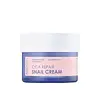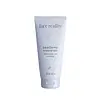What's inside
What's inside
 Key Ingredients
Key Ingredients

 Benefits
Benefits

 Concerns
Concerns

 Ingredients Side-by-side
Ingredients Side-by-side

Snail Secretion Filtrate 88%
Skin ConditioningDimethicone
EmollientNiacinamide
SmoothingCetearyl Olivate
Sorbitan Olivate
EmulsifyingButylene Glycol
HumectantCaprylic/Capric Triglyceride
MaskingCetyl Alcohol
EmollientStearyl Alcohol
EmollientArtemisia Capillaris Extract
Glyceryl Stearate
EmollientCarbomer
Emulsion StabilisingTromethamine
BufferingPolyacrylate-13
Palmitic Acid
EmollientStearic Acid
CleansingEthylhexylglycerin
Skin ConditioningSodium Hyaluronate
HumectantPolyisobutene
Sodium Polyacrylate
AbsorbentPyrus Communis Fruit Extract
Skin ConditioningRosa Damascena Flower Water
MaskingHedera Helix Leaf/Stem Extract
AntimicrobialAdenosine
Skin ConditioningFragaria Chiloensis Fruit Extract
Skin ConditioningOlea Europaea Fruit Extract
BleachingPimpinella Anisum Fruit Extract
MaskingPolysorbate 20
EmulsifyingSorbitan Isostearate
EmulsifyingWater
Skin ConditioningButyl Avocadate
Skin ConditioningCentella Asiatica Extract
CleansingPunica Granatum Fruit Extract
AntioxidantGlycerin
HumectantAsiaticoside
AntioxidantMadecassic Acid
Skin Conditioning1,2-Hexanediol
Skin ConditioningVaccinium Macrocarpon Fruit Extract
AstringentRubus Idaeus Fruit Extract
AstringentVaccinium Angustifolium Fruit Extract
Skin ProtectingCornus Officinalis Fruit Extract
Skin ConditioningEuterpe Oleracea Fruit Extract
Sambucus Nigra Fruit Extract
AstringentSchisandra Chinensis Fruit Extract
Skin ConditioningPanax Ginseng Berry Extract
Skin ConditioningVaccinium Myrtillus Fruit Extract
Skin ConditioningEpilobium Fleischeri Extract
Skin ConditioningCitric Acid
BufferingPotassium Sorbate
PreservativeHydrolyzed Hyaluronic Acid
HumectantHibiscus Sabdariffa Flower Extract
Skin ConditioningPropyl Gallate
AntioxidantMadecassoside
AntioxidantSnail Secretion Filtrate 88%, Dimethicone, Niacinamide, Cetearyl Olivate, Sorbitan Olivate, Butylene Glycol, Caprylic/Capric Triglyceride, Cetyl Alcohol, Stearyl Alcohol, Artemisia Capillaris Extract, Glyceryl Stearate, Carbomer, Tromethamine, Polyacrylate-13, Palmitic Acid, Stearic Acid, Ethylhexylglycerin, Sodium Hyaluronate, Polyisobutene, Sodium Polyacrylate, Pyrus Communis Fruit Extract, Rosa Damascena Flower Water, Hedera Helix Leaf/Stem Extract, Adenosine, Fragaria Chiloensis Fruit Extract, Olea Europaea Fruit Extract, Pimpinella Anisum Fruit Extract, Polysorbate 20, Sorbitan Isostearate, Water, Butyl Avocadate, Centella Asiatica Extract, Punica Granatum Fruit Extract, Glycerin, Asiaticoside, Madecassic Acid, 1,2-Hexanediol, Vaccinium Macrocarpon Fruit Extract, Rubus Idaeus Fruit Extract, Vaccinium Angustifolium Fruit Extract, Cornus Officinalis Fruit Extract, Euterpe Oleracea Fruit Extract, Sambucus Nigra Fruit Extract, Schisandra Chinensis Fruit Extract, Panax Ginseng Berry Extract, Vaccinium Myrtillus Fruit Extract, Epilobium Fleischeri Extract, Citric Acid, Potassium Sorbate, Hydrolyzed Hyaluronic Acid, Hibiscus Sabdariffa Flower Extract, Propyl Gallate, Madecassoside
Water
Skin ConditioningCaprylic/Capric Triglyceride
MaskingCoco-Caprylate/Caprate
EmollientCetearyl Alcohol
EmollientGlyceryl Stearate
EmollientGlycerin
HumectantTapioca Starch
Cetearyl Olivate
Niacinamide
SmoothingCarthamus Tinctorius Seed Oil
MaskingPhenoxyethanol
PreservativeAlcohol Denat.
AntimicrobialSorbitan Olivate
EmulsifyingStearic Acid
CleansingCarbomer
Emulsion StabilisingPolysorbate 20
EmulsifyingPolysorbate 60
EmulsifyingEthylhexylglycerin
Skin ConditioningPotassium Sorbate
PreservativeAllantoin
Skin ConditioningBisabolol
MaskingMaltodextrin
AbsorbentHamamelis Virginiana Water
AstringentCitric Acid
BufferingSodium Hydroxide
BufferingFructooligosaccharides
HumectantCitrus Nobilis Peel Oil
MaskingCamellia Sinensis Leaf Extract
AntimicrobialChamomilla Recutita Flower Extract
MaskingSyringa Vulgaris Leaf Cell Culture Extract
Skin ConditioningTotarol
AntioxidantGlycyrrhiza Glabra Root Extract
BleachingCitrus Aurantium Dulcis Peel Oil
MaskingVaccinium Macrocarpon Fruit Extract
AstringentWater, Caprylic/Capric Triglyceride, Coco-Caprylate/Caprate, Cetearyl Alcohol, Glyceryl Stearate, Glycerin, Tapioca Starch, Cetearyl Olivate, Niacinamide, Carthamus Tinctorius Seed Oil, Phenoxyethanol, Alcohol Denat., Sorbitan Olivate, Stearic Acid, Carbomer, Polysorbate 20, Polysorbate 60, Ethylhexylglycerin, Potassium Sorbate, Allantoin, Bisabolol, Maltodextrin, Hamamelis Virginiana Water, Citric Acid, Sodium Hydroxide, Fructooligosaccharides, Citrus Nobilis Peel Oil, Camellia Sinensis Leaf Extract, Chamomilla Recutita Flower Extract, Syringa Vulgaris Leaf Cell Culture Extract, Totarol, Glycyrrhiza Glabra Root Extract, Citrus Aurantium Dulcis Peel Oil, Vaccinium Macrocarpon Fruit Extract
Ingredients Explained
These ingredients are found in both products.
Ingredients higher up in an ingredient list are typically present in a larger amount.
This ingredient is an emollient, solvent, and texture enhancer. It is considered a skin-softener by helping the skin prevent moisture loss.
It helps thicken a product's formula and makes it easier to spread by dissolving clumping compounds.
Caprylic Triglyceride is made by combining glycerin with coconut oil, forming a clear liquid.
While there is an assumption Caprylic Triglyceride can clog pores due to it being derived from coconut oil, there is no research supporting this.
Learn more about Caprylic/Capric TriglycerideCarbomer is a polymer of acrylic acid. Its main role is to create a gel consistency.
A high amount of carbomer can cause pilling or balling up of products. Don't worry, most products contain 1% or less of carbomer.
Cetearyl Olivate is an emulsifier and texture enhancer. It is derived from the fatty acids of olive oil and Cetearyl alcohol, and is biodegradable.
As an emulsifier, it is used to prevent oils and waters from separating. It can also
Manufacturers use the name Olivem 1000. This ingredient has been found to preserve the natural microbiome of skin. Having a healthy microbiome helps keep our skin healthy and protects against harmful bacteria. This ingredient is grouped with Sorbitan Olivate under the name Olivem 1000.
Learn more about Cetearyl OlivateCitric Acid is an alpha hydroxy acid (AHA) naturally found in citrus fruits like oranges, lemons, and limes.
Like other AHAs, citric acid can exfoliate skin by breaking down the bonds that hold dead skin cells together. This helps reveal smoother and brighter skin underneath.
However, this exfoliating effect only happens at high concentrations (20%) which can be hard to find in cosmetic products.
Due to this, citric acid is usually included in small amounts as a pH adjuster. This helps keep products slightly more acidic and compatible with skin's natural pH.
In skincare formulas, citric acid can:
While it can provide some skin benefits, research shows lactic acid and glycolic acid are generally more effective and less irritating exfoliants.
Most citric acid used in skincare today is made by fermenting sugars (usually from molasses). This synthetic version is identical to the natural citrus form but easier to stabilize and use in formulations.
Read more about some other popular AHA's here:
Learn more about Citric AcidEthylhexylglycerin (we can't pronounce this either) is commonly used as a preservative and skin softener. It is derived from glyceryl.
You might see Ethylhexylglycerin often paired with other preservatives such as phenoxyethanol. Ethylhexylglycerin has been found to increase the effectiveness of these other preservatives.
Glycerin is already naturally found in your skin. It helps moisturize and protect your skin.
A study from 2016 found glycerin to be more effective as a humectant than AHAs and hyaluronic acid.
As a humectant, it helps the skin stay hydrated by pulling moisture to your skin. The low molecular weight of glycerin allows it to pull moisture into the deeper layers of your skin.
Hydrated skin improves your skin barrier; Your skin barrier helps protect against irritants and bacteria.
Glycerin has also been found to have antimicrobial and antiviral properties. Due to these properties, glycerin is often used in wound and burn treatments.
In cosmetics, glycerin is usually derived from plants such as soybean or palm. However, it can also be sourced from animals, such as tallow or animal fat.
This ingredient is organic, colorless, odorless, and non-toxic.
Glycerin is the name for this ingredient in American English. British English uses Glycerol/Glycerine.
Learn more about GlycerinGlyceryl Stearate is a mix of glycerin and stearic acid.
It is used to stabilize the mixing of water and oil ingredients. By preventing these ingredients from separating, it can help elongate shelf life. It can also help thicken the product's texture.
As an emollient, it helps soften skin and supports barrier-replenishing ingredients.
In cosmetics, Glyceryl Stearate is often made from vegetable oils or synthetically produced.
This ingredient may not be fungal-acne safe
Fun fact: The human body also creates Glyceryl Stearate naturally.
Learn more about Glyceryl StearateNiacinamide is a multitasking form of vitamin B3 that strengthens the skin barrier, reduces pores and dark spots, regulates oil, and improves signs of aging.
And the best part? It's gentle and well-tolerated by most skin types, including sensitive and reactive skin.
You might have heard of "niacin flush", or the reddening of skin that causes itchiness. Niacinamide has not been found to cause this.
In very rare cases, some individuals may not be able to tolerate niacinamide at all or experience an allergic reaction to it.
If you are experiencing flaking, irritation, and dryness with this ingredient, be sure to double check all your products as this ingredient can be found in all categories of skincare.
When incorporating niacinamide into your routine, look out for concentration amounts. Typically, 5% niacinamide provides benefits such as fading dark spots. However, if you have sensitive skin, it is better to begin with a smaller concentration.
When you apply niacinamide to your skin, your body converts it into nicotinamide adenine dinucleotide (NAD). NAD is an essential coenzyme that is already found in your cells as "fuel" and powers countless biological processes.
In your skin, NAD helps repair cell damage, produce new healthy cells, support collagen production, strengthen the skin barrier, and fight environmental stressors (like UV and pollution).
Our natural NAD levels start to decline with age, leading to slower skin repair, visible aging, and a weaker skin barrier. By providing your skin niacinamide, you're recharging your skin's NAD levels. This leads to stronger, healthier, and younger looking skin.
Another name for vitamin B3 is nicotinamide. This vitamin is water-soluble and our bodies don't store it. We obtain Vitamin B3 from either food or skincare. Meat, fish, wheat, yeast, and leafy greens contain vitamin B3.
The type of niacinamide used in skincare is synthetically created.
Learn more about NiacinamidePolysorbate 20 is made by combining ethoxylation of sorbitan, ethylene oxide, and lauric acid. It is a mild cleansing agent, surfactant, and emulsifier.
As a surfactant, it helps collect dirt and oils for washing. Emulsifiers prevent oils and water from separating.
Polysorbate 20 also adds scent to a product. Since it is made using sorbitol, it has a sweet scent. Sorbitol can also be found in fruits such as apples and peaches.
The lauric acid used to create Polysorbate 20 is often derived from coconuts.
Polysorbate 20 may not be fungal acne safe.
Learn more about Polysorbate 20Potassium Sorbate is a preservative used to prevent yeast and mold in products. It is commonly found in both cosmetic and food products.
This ingredient comes from potassium salt derived from sorbic acid. Sorbic acid is a natural antibiotic and effective against fungus.
Both potassium sorbate and sorbic acid can be found in baked goods, cheeses, dried meats, dried fruit, ice cream, pickles, wine, yogurt, and more.
You'll often find this ingredient used with other preservatives.
Learn more about Potassium SorbateSorbitan Olivate is created from the fatty acids in olive oil and sorbitol.
This ingredient is an oil in water emulsifier. It helps stabilize a product by preventing oils and waters from separating. Sorbitan Olivate also helps hydrate the skin.
Manufacturers sell sorbitan olivate under the name OliveM 1000. OliveM 1000 a multifunctional ingredient. It is self-emulsifying. According to a manufacturer, OliveM 1000 does not disrupt natural skin biome.
Due to its olive oil base, this ingredient may not be fungal-acne safe.
Learn more about Sorbitan OlivateStearic Acid is a fatty acid. It is an emollient, emulsifier, and texture enhancer.
As an emollient, stearic acid helps soften skin. It aids the skin's protective barrier by preventing water loss. It also provides a gentle cleansing effect without stripping away natural oils.
Stearic acid may also be used to enhance the texture of products. It can add volume and stabilize ingredients such as water and oil. This can help water and oil ingredients from separating.
Sources of stearic acid include animal or vegetable fats/oils such as coconut or shea. It can be naturally found in butter, cocoa butter, shea butter, vegetable fats, and animal tallow.
This ingredient may not be Malassezia folliculitis, or fungal-acne safe.
Learn more about Stearic AcidVaccinium Macrocarpon Fruit Extract comes from the cranberry fruit. Vaccinium Macrocarpon is the North American species of cranberries native to eastern Canada.
As an astringent, cranberry extract helps tighten the pores by constricting the cells.
Cranberries contain Vitamin E and Vitamin C, both potent antioxidants. It also contains minerals such as manganese and copper.
Learn more about Vaccinium Macrocarpon Fruit ExtractWater. It's the most common cosmetic ingredient of all. You'll usually see it at the top of ingredient lists, meaning that it makes up the largest part of the product.
So why is it so popular? Water most often acts as a solvent - this means that it helps dissolve other ingredients into the formulation.
You'll also recognize water as that liquid we all need to stay alive. If you see this, drink a glass of water. Stay hydrated!
Learn more about Water